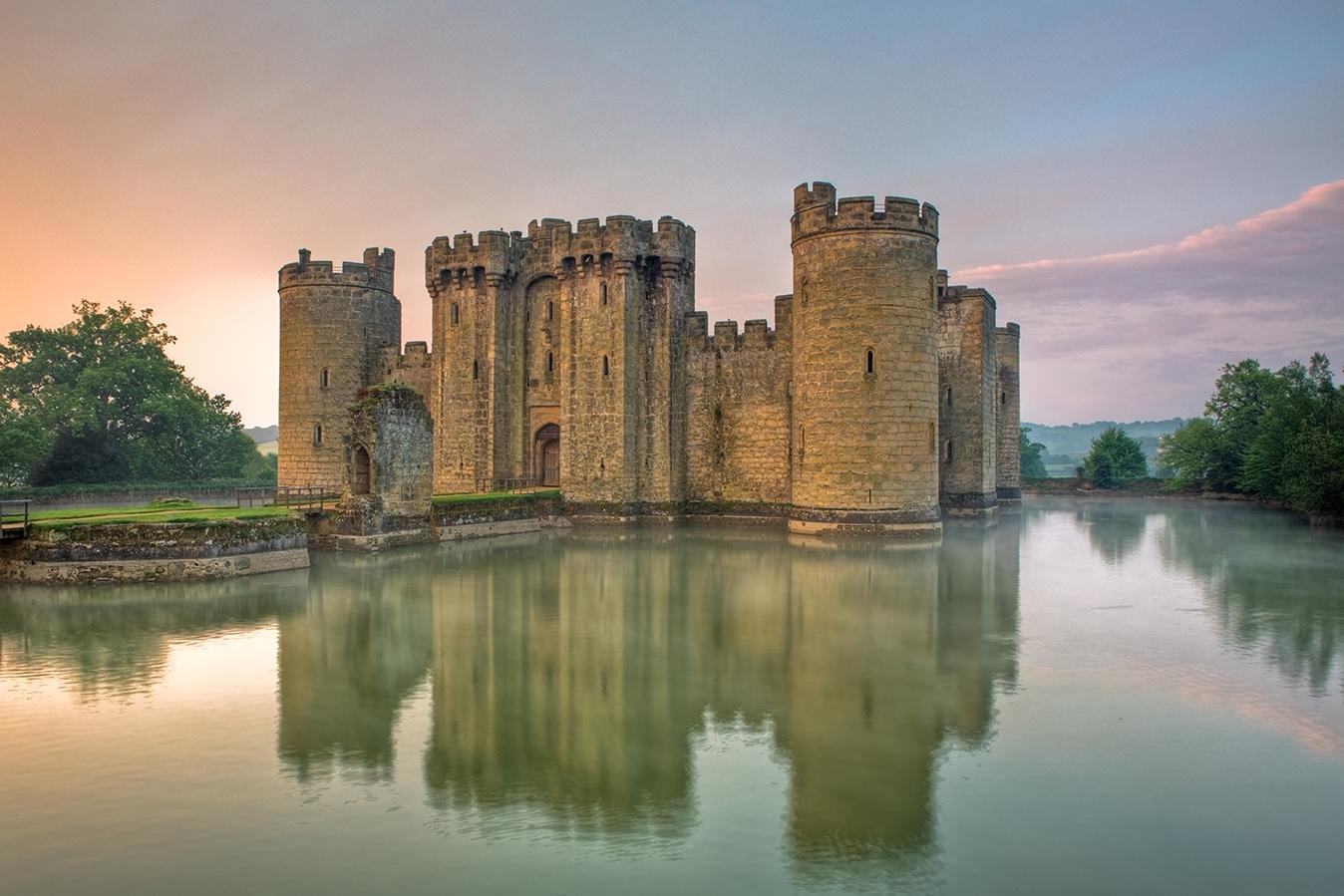
Bodiam Castle has been capturing people’s imaginations for over 600 years, with its grand turrets peeking above the trees and its waterside reflections shimmering in the moat,.
The Mighty Bodiam: A Look at This Iconic English Castle
The Origins of Bodiam Castle
While we may see Bodiam as a beautiful ruin today, in its heyday it was a formidable fortress built for defense. It was constructed in the late 14th century by Sir Edward Dalyngrigge, a former knight who fought in the prolonged Hundred Years’ War between England and France. After returning home, Edward decided to build a castle in a strategic location to defend the area around Bodiam, East Sussex.
Why Bodiam Was Built
Bodiam Castle went up quickly – about seven years – and replaced an older manor home on the site. But why did Edward Dalyngrigge feel compelled to build such an imposing castle? Bodiam was intended to be part fortress and part stately home. The castle guarded an important route on the River Rother, allowing Edward to control river traffic. The four corner towers provided lookout points should any threats arise. Beyond defense, Bodiam Castle was also a luxurious home reflecting Edward’s wealth and status.

Building a Mighty Medieval Fortress
Bodiam Castle was built to be an imposing medieval fortress, meant to both defend and impress. Its remarkable design and construction gave Bodiam the majestic appearance it still retains today.
Choosing the Location
The site Edward Dalyngrigge chose for the castle was no accident. He selected a strategic bend in the River Rother that allowed him to control traffic on the river. The river also acted as a natural defense on one side, meaning walls only had to be built on three sides. The marshy, low-lying land around the castle made it difficult to attack.
Constructing Sturdy Walls
Bodiam’s mighty walls were made to withstand enemy sieges. Sandstone from nearby quarries was used to build the outer walls up to 9 feet thick in places. The walls form an imposing rectangular shape with circular towers rising at each of the four corners. These towers provided lookout points and places for archers to defend the castle.

Fortifying the Castle
In addition to its sheer imposing walls and elevated corner towers, other fortifying features were included in Bodiam’s design. The castle had a deep moat surrounding it that acted as an obstacle to invaders. Arrow slits and holes in the walls allowed defenders to shoot arrows and pour boiling oil or water. A barbican, or fortified gateway, controlled access to the castle.
Magnificent Ruins
While the castle is an impressive sight today, what visitors see are the ruins of what was once a mighty medieval fortress. Over the centuries, time and neglect left only the exterior walls standing. Yet these remnants have their own unique magnificence and provide insight into England’s past.
The Decay of Time
After the Middle Ages, Bodiam Castle passed through different owners and slowly started to deteriorate. Sections of the towers and buildings inside the walls collapsed over time. During the English Civil War in the 1600s, some of the castle was stripped and vandalized. What remains today are mainly the imposing outer walls and corner towers.
Neglected But Not Forgotten
For centuries after its medieval heyday, Bodiam Castle sat neglected and ignored. Locals used its fallen stones for other building projects in the town. Trees and ivy crept up the walls. Yet Bodiam’s imposing presence on the landscape was never forgotten. And in the 1800s, its historical significance was recognized.
Preserving the Ruins
In the Victorian era, Bodiam Castle inspired painters who romanticized its ruined yet picturesque state. This attention helped spur preservation efforts starting in the 1800s by organizations like The National Trust. While no longer the functioning fortress it once was, the ruins of Bodiam now evoke the splendor of medieval England for visitors.
The Enduring Legacy of Bodiam
Over 600 years since it was built, the castle continues to capture people’s imaginations and stand as an icon of England’s history. Though a ruin, its imposing walls remind us of England’s tumultuous past and the castles that once dotted the landscape.
Inspiring Artists
During the Victorian era, Bodiam Castle became a popular destination for artists seeking to capture its evocative ruins. Painters like J.M.W. Turner helped share the castle’s beauty with a public increasingly interested in medieval history. Bodiam continues to inspire modern photographers as well.
Preserving History
Today, Bodiam is managed by the National Trust, who work to maintain and preserve the ruins. While no longer the functioning castle it was, what remains of Bodiam is one of the best examples of a 14th century medieval quadrangular castle. It provides insight into both castle design and everyday life in the Middle Ages.
A Link to the Past
Bodiam Castle connects us to England’s medieval history in a unique way. As visitors walk inside its ruined walls, they can envision what life was like in a mighty fortress hundreds of years ago. This ability to kindle imaginations helps explain why Bodiam has endured as an iconic castle and popular tourist attraction.
How to Find Bodiam Castle
Places to stay
Related Articles
Related Articles
The Middle Ages in England
The Middle Ages in England span from around 500-1500 AD, covering over 1000 years of English history.
Uncovering the Hidden Histories of England and Wales’ Overlooked Castles
Many lesser-known castles around England and Wales have their own unique histories that are fascinating to uncover.
5 Facts About the Tower of London
Discover the rich history and secrets with these 5 fascinating facts about the Tower of London, a symbol of royal power and intrigue for centuries.





